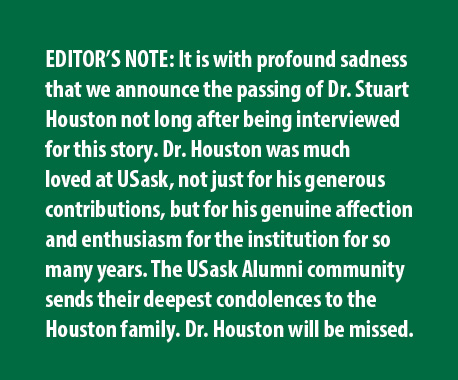USask research is for the birds
The legacy of a conservationist lives on through her $2.3-million gift and allows USask researchers and students to soar.
By John GraingerDr. Karen Wiebe (Photography: Submitted)
It would be hard to count the number of birds that Mary Houston (BA’47, BEd’50, S.V.M.) banded during her lifetime.
All sorts of birds. Thousands of birds. Bohemian Waxwings. Mountain Bluebirds. Sparrows. Redpolls. Purple Martins. You name it and Mary had probably put a band on it somewhere. It might have been in a field. Perhaps in a forest. Always in her backyard.
But there were two birds Mary never touched, recounts her husband, Dr. Stuart Houston (DL’87).
“She drew the line at golden eagles,” said Stuart. “She never repelled down a rope to a golden eagle nest. And she never climbed a tree to a Great Horned Owl nest.”

No matter the location, Mary always wanted to band birds, which helps identify and track them. Her husband was always happy to work alongside her.
It’s that passion the Houstons wanted to see continued when in 2002 they created the Stuart and Mary Houston Professorship in Ornithology at USask’s Department of Biology. After Mary passed away in 2019, her legacy gift of nearly $2.3 million has amplified the research impact of the professorship.
To be selected, the professor is expected to be a prominent and active participant in ornithological research and to contribute to graduate and undergraduate teaching.
Dr. Karen Wiebe (PhD) has been the recipient of the professorship and has been able to advance her work exponentially because of Mary’s generosity.
“The financial support from the Houstons has been invaluable to my research program by allowing me to focus on ‘basic’ or curiosity-driven questions of bird behaviour,” said the USask biologist, in an emailed statement from the mountains in British Columbia where she is conducting research.
“In other words, research grants in animal ecology are increasingly tied to industry and focused on applied questions of interest to industrial partners, but these funds have allowed me the freedom to support graduate students who wish to study theoretical aspects of behaviour, and to learn about avian biology for its own sake.”
Wiebe says she feels a special connection with Mary even to this day.
“Mary was very involved with setting up a trail of bluebird boxes around Saskatoon, and she monitored them for many years. So, I always think especially of Mary Houston when studying bluebirds in particular.”
Others around the world also had a special connection with Mary. Her banding effort wasn’t just a local pursuit. Her work became legendary and was known throughout the world by researchers, academics, and birding enthusiasts alike.
Stuart says Mary’s interest in birding started years ago while she was a teacher for the Yorkton school board. Incidentally, Stuart’s father, who was chair of the local school board, thought Stuart should meet Mary Belcher. It turned out to be sage advice as the pair would have celebrated their 70th anniversary in August 2020. They also raised four children: Stanley, Margaret, David and Donald.
Stuart’s career in medicine blossomed and he joined the department of diagnostic radiology at USask in 1964 before becoming a professor five years later. Working alongside luminaries like Sylvia Fedoruk, Stuart retired as professor emeritus in 1996 after a distinguished academic career in which he was a renowned authority in that discipline.

“Just about everything that I succeeded in, Mary was the strength behind me. We made a good team,” said Stuart.
Together, however, their mutual passion for birds took flight early in their relationship. When they heard the bluebird population in the Yorkton area was dropping, they wanted to do something to help restore the numbers. They started building birdhouses. Many birdhouses. Birdhouses for all types of birds.
As their passion for birds grew, Mary left her teaching career so she could devote more time to banding birds and protecting their habitats.
Over her banding career, Mary received many awards and accolades including being one of the first elected fellows of the Saskatchewan Natural History Society in 1987. Mary also received the Douglas H. Pimlott Conservation Award from the Canadian Nature Federation in 1988. Mary was added to the USask College of Education’s Alumni Wall of Honour in 2010 and named an Alumni of Influence from the College of Arts and Science in 2013.
Mary’s banding exploits are legendary for the sheer volume and commitment she displayed. In fact, she has banded more Bohemian Waxwings personally than every other North American bander combined.
The immense knowledge she obtained in her pursuits put her on a different level, Stuart maintains.
“Mary was just heads and shoulders above everybody else because she had a very bright mind. But above all, she was a very modest woman. And, of course, everybody loved her.
“As you can see, I’m very proud of her,” said Stuart.
Thanks to your support, the University of Saskatchewan can dream big. Together, we will make transformative and positive changes by addressing issues that impact our world now and the world that future generations will inherit.
Your gift, no matter the size, helps to lift us all up. To donate, please visit donate.usask.ca.


